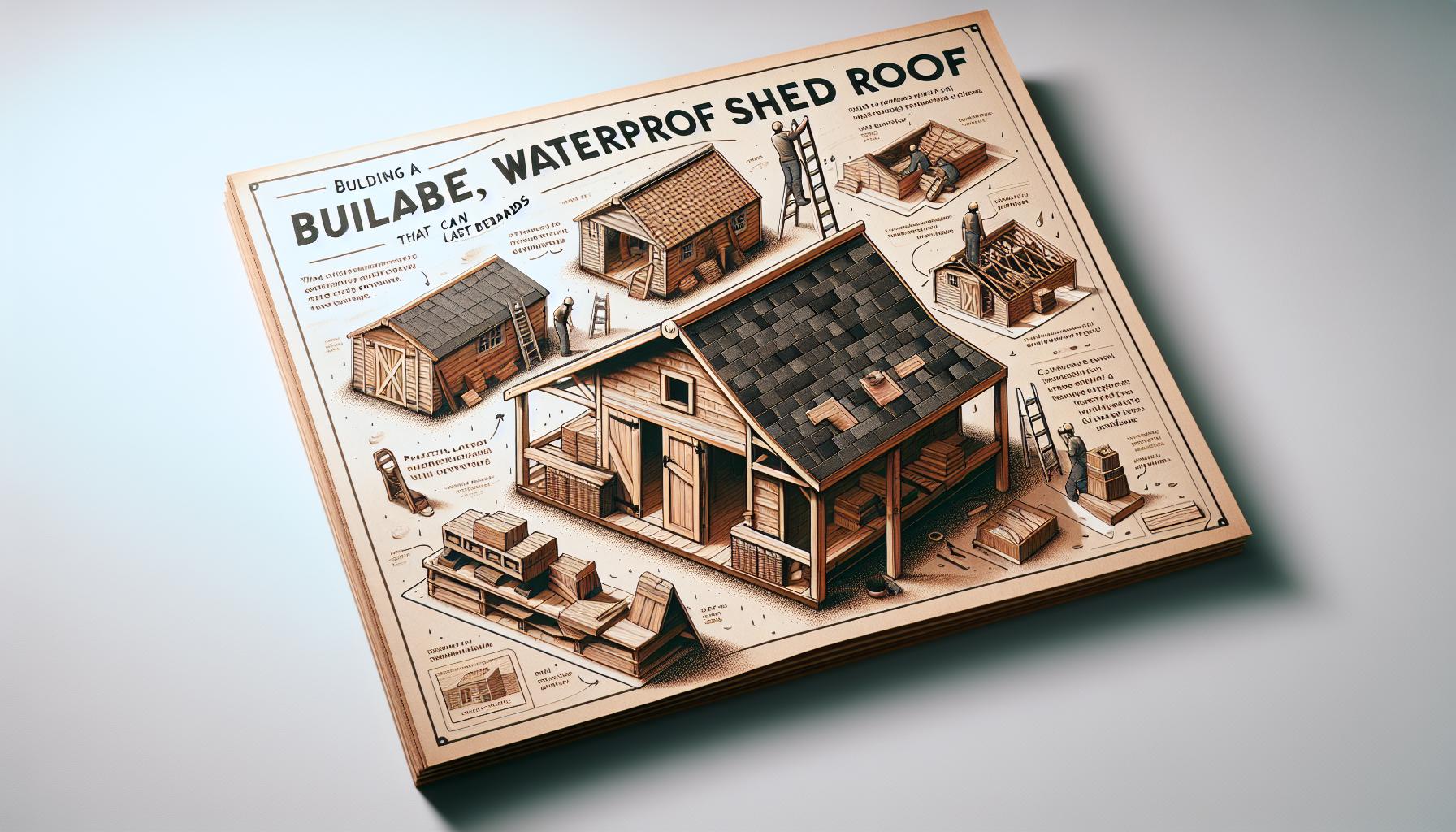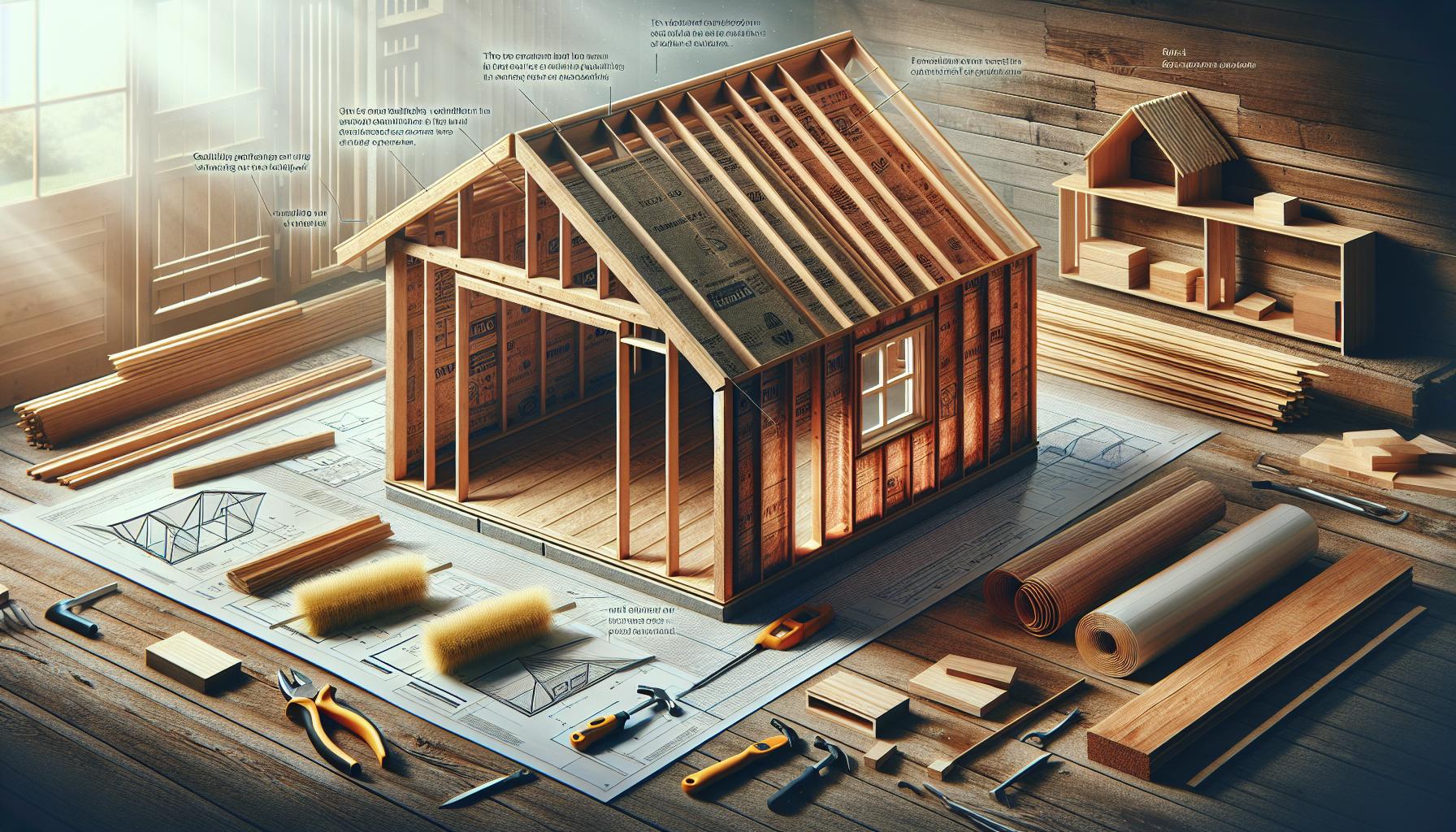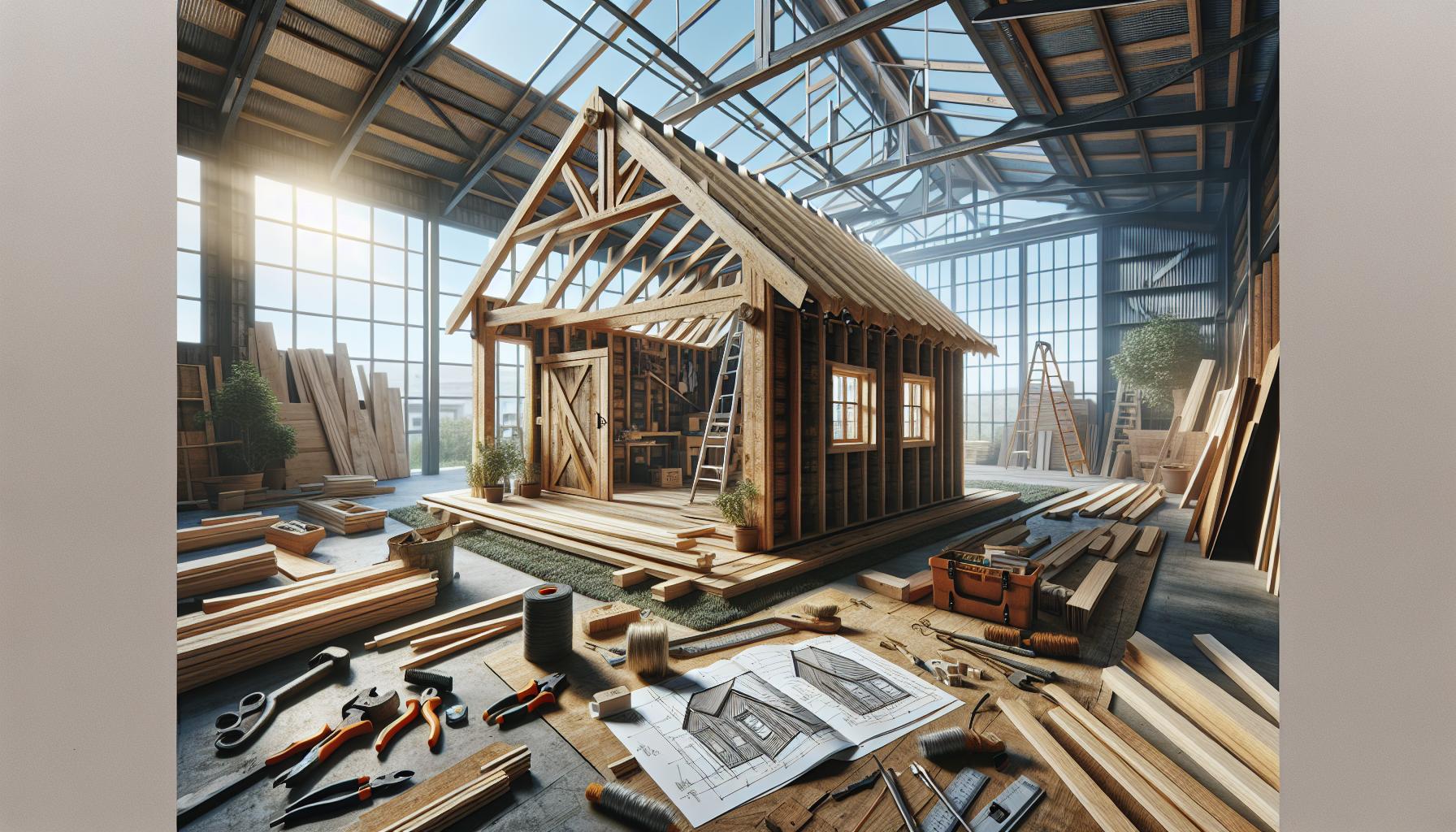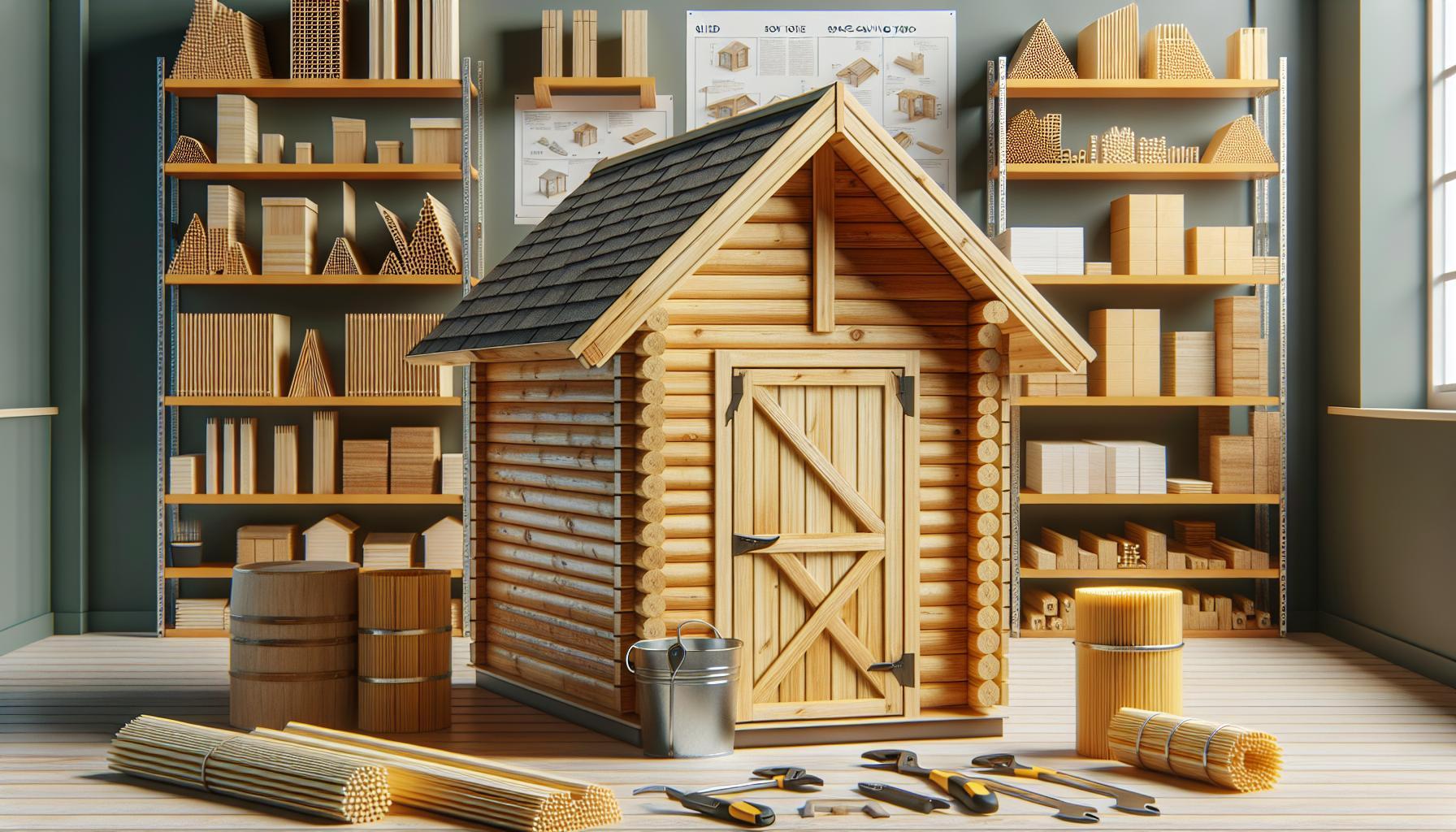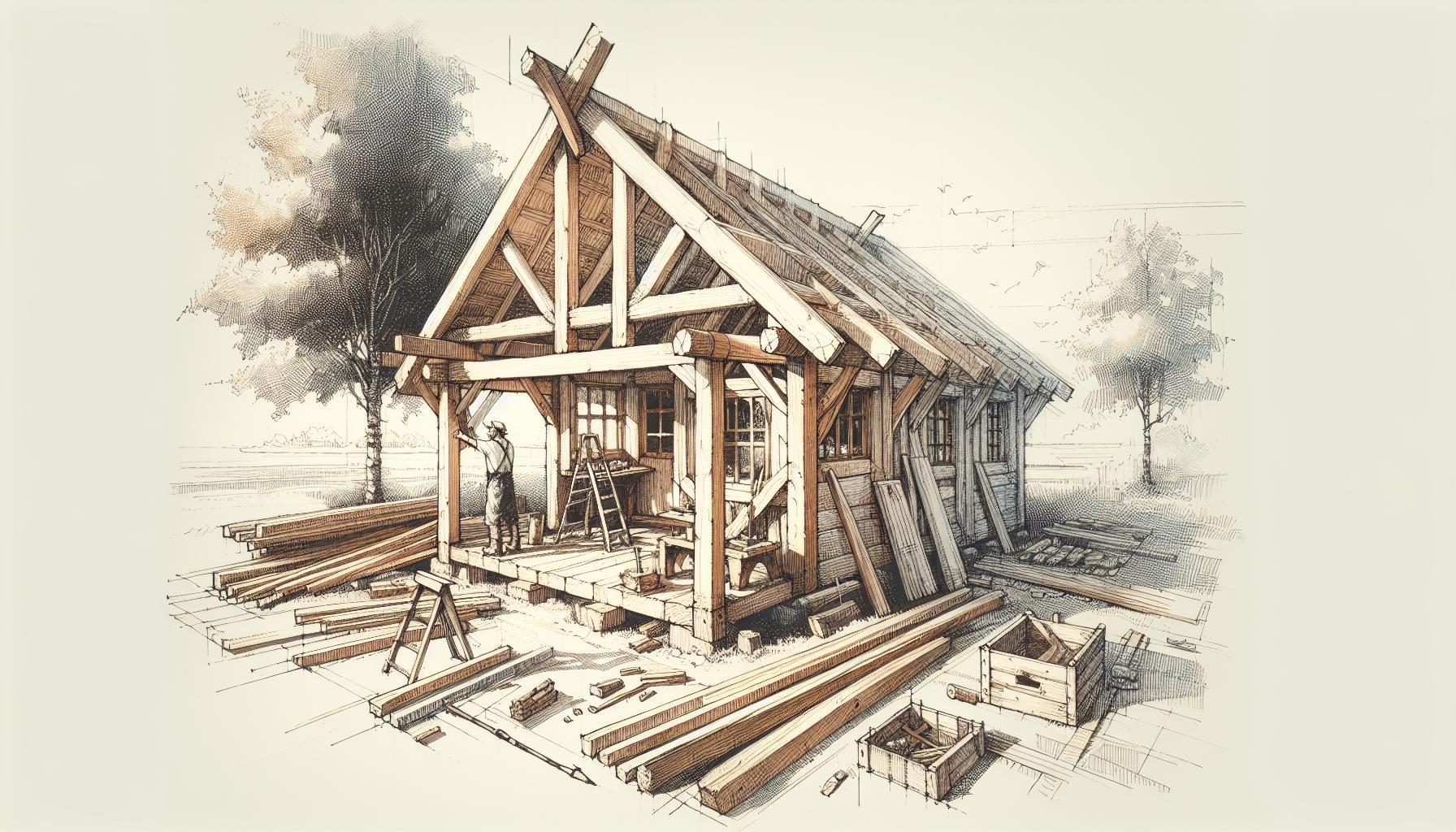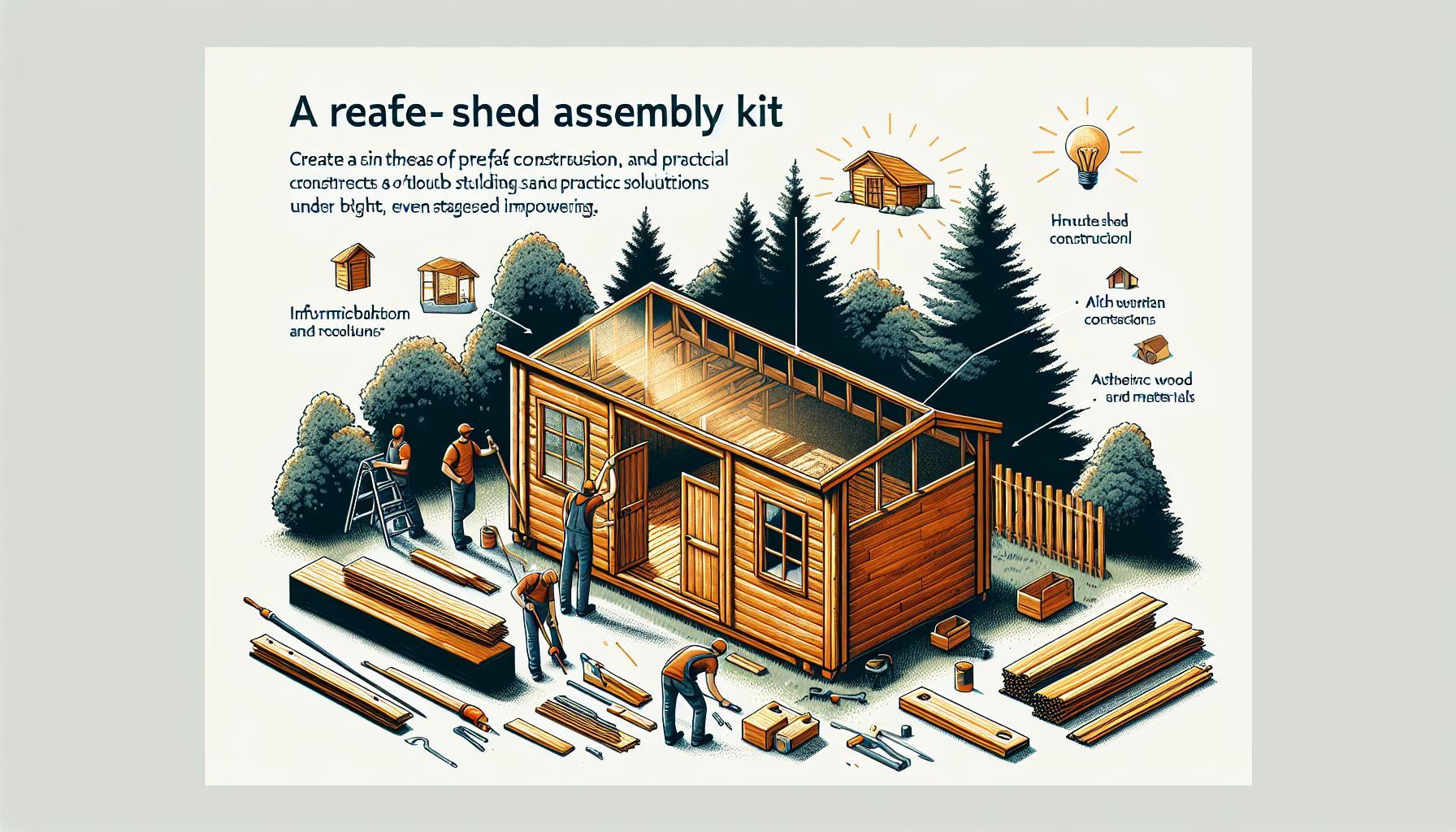Wondering how to create a durable and waterproof shed roof that can withstand the test of time? Building a reliable roof is essential for protecting yoru tools and keeping your workspace dry. In this guide, we’ll explore practical designs and techniques that ensure your shed remains watertight for decades to come.
Understanding Shed Roof Types: Choosing the Right Design for Your Needs
Choosing the right shed roof design can significantly impact the functionality and longevity of your structure. With various styles available, understanding their characteristics is crucial. From the aesthetically pleasing gable roof to the utilitarian lean-to style,each option serves different needs and preferences. This diversity allows homeowners to balance practicality with personal aesthetics, ensuring their shed not only performs well but also blends seamlessly with the surrounding habitat.
Popular Shed Roof Types
Among the most common shed roof types are:
- Gable Roof: This classic design features two sloping sides that meet at a ridge.It is effective for water drainage,making it a great choice for wet climates.
- Lean-To Roof: This option consists of a single sloped roof, easily attached to the side of a taller structure. Its perfect for maximizing space while being budget-kind.
- Skillion Roof: Similar to a lean-to, but with a steeper slope, this design allows for better water runoff and can provide higher ceilings for storage.
- Flat Roof: Even though the name suggests a lack of slope, a properly constructed flat roof will have a slight pitch to prevent water pooling. This design is often simpler and quicker to build.
When evaluating these options, consider the climate in your area as well as the intended use of your shed.For instance,if you live in a region with heavy snowfall,a gable or skillion roof might be ideal due to their ability to shed snow effectively. Conversely, a lean-to design might serve well in an urban environment where space is limited and you need a simple storage solution.
Additional Considerations
It’s essential not only to choose a roof style based on aesthetics but also on functionality. Different materials can enhance the waterproof qualities of your shed roof. Options include:
| Material | Pros | Cons |
|---|---|---|
| Metal | Durable, lightweight, excellent for rain and snow | Can be noisy during heavy rain, potential for rust |
| Asphalt Shingles | cost-effective, available in various colors | Less durable than other options, may need replacement after 20-30 years |
| Wood Shake | Aesthetic appeal, great insulator | Requires regular maintenance to prevent rot |
| Tiles | Long-lasting, good for various climates | heavy, may require additional support |
by carefully selecting both the style and materials for your shed roof, you can achieve a waterproof design that lasts decades. Always consider local building codes and consult with a professional if you’re unsure about the best approach for your project. Making informed decisions now will ensure your shed remains functional and visually appealing for years to come.
Essential Materials for Building a durable Shed Roof
When embarking on the journey of constructing a shed roof that stands the test of time, understanding the essential materials is key. Choosing the right components not only ensures durability but also protects your investment against the elements for decades. Each material plays a critical role in the overall integrity and performance of your shed roof, making it vital to know what options are available and how they contribute to a waterproof design.
Roofing Materials
Selecting the correct roofing material is the foundation of a robust shed roof. Hear are some popular choices:
- Asphalt Shingles: Affordable and easy to install, asphalt shingles offer decent waterproofing and come in a variety of styles and colors. However, their lifespan is typically around 20-30 years.
- Metal Roofing: Known for its longevity (often lasting 50 years or more), metal roofing is lightweight and resistant to extreme weather conditions. It’s also fire-resistant and can reflect heat, making your shed cooler in the summer.
- EPDM Rubber: Ideal for flat roofs, EPDM is a synthetic rubber that provides excellent waterproofing. Its flexibility allows it to expand and contract without cracking, ensuring a tight seal against leaks.
- Tile or Slate: While more expensive, tile and slate roofs offer unbelievable durability and aesthetic appeal. Both materials can last over 100 years if properly maintained.
Supporting Structures
Moreover, the framework that supports the roof is just as important. The right lumber and engineering choices can greatly affect the roof’s durability:
- Pressure-Treated Lumber: Essential for areas exposed to moisture, pressure-treated wood resists rot and insect damage, ensuring a sturdy base for your roof.
- Roof Trusses: engineered trusses distribute weight evenly,providing structural integrity and reducing the chances of bowing or sagging over time.
- OSB (Oriented Strand Board) or Plywood: Used for sheathing, these materials provide a solid surface for your roofing materials and add an extra layer of insulation against leaks.
waterproofing Elements
Incorporating waterproofing features is essential in any design aimed at longevity. Consider these elements:
- Underlayment: A waterproof membrane laid under roofing materials,it acts as a barrier against moisture infiltration,adding an extra layer of protection.
- Flashings: Metal flashings installed around chimneys,vents,and seams help direct water away and prevent leaks,crucial for maintaining the integrity of the roof.
Investing in high-quality materials for your shed roof not only enhances its aesthetic appeal but also ensures it withstands harsh weather conditions, giving you peace of mind for years to come. By carefully selecting from the options available and considering your specific needs, you can confidently answer the question of how to build a shed roof that is both functional and waterproof.
Step-by-Step Guide to Constructing a Waterproof Shed Roof
Constructing a waterproof shed roof is essential for extending the lifespan of your shed,safeguarding its contents,and ensuring functionality through all weather conditions. To achieve a shed roof that remains impervious to the elements, you need to approach the project with careful planning, quality materials, and systematic execution. Here’s a comprehensive guide to lead you through the process seamlessly.
Planning Your Shed Roof
Before diving into construction, it’s crucial to strategize your design. Consider these steps:
- determine the Roof Type: The two most common shed roof styles are gable and flat. Gable roofs are typically more effective at draining water and resisting snow accumulation.
- Choose Appropriate Materials: Select materials that not only suit your aesthetic preferences but also offer superior waterproofing capabilities. Common options include metal sheets, asphalt shingles, or rubber roofing.
- Assess Drainage Needs: Proper slope is critical to ensure water runs off efficiently.Aim for a minimum slope of 2:12 (2 inches of rise for every 12 inches of run).
Building the Framework
Once you’ve outlined your plan, it’s time to construct the roof’s framework. Follow these actionable steps:
- Build Roof Trusses: Create triangular trusses using 2×4 lumber for strength. Use the following dimensions for a simple gable roof:
| Component | Dimensions |
|---|---|
| Base | 4 ft x 2 ft |
| Height (Peak) | 2 ft |
- Install Roof Plywood: Attach exterior-grade plywood to the trusses to provide stability and a base for your roofing material.
- Add a Waterproof Barrier: Before installing the roofing material, lay down a waterproof barrier (like roofing felt) to further protect against leaks.
Applying Roofing Materials
Now we reach the step where waterproofing truly takes form. Selecting and applying the correct roofing material is pivotal:
- Metal Roofing: If you choose metal sheets, ensure they overlap correctly and use rubber gaskets on screws to prevent leaks.
- Asphalt Shingles: For shingles, start from the bottom and overlap each row adequately, adhering to the manufacturer’s specifications regarding nail spacing.
- rubber Roofing: for a flat roof, consider applying a rubber membrane for seamless waterproofing. Ensure the seams are properly sealed to avoid any water ingress.
With a diligent approach to building your shed roof,you can achieve a waterproof design that not only protects your shed but also stands the test of time. Following these step-by-step instructions will help ensure that your construction mimics the principles discussed in the in-depth guide to building waterproof shed roofs effectively.
Tips for Proper Shed Roof Insulation and Ventilation
ensuring your shed operates efficiently is not just about using high-quality materials; proper insulation and ventilation play a vital role in maintaining the ideal environment inside. Poorly insulated sheds can lead to significant temperature fluctuations, moisture buildup, and the eventual degradation of stored tools and equipment. To enhance both the longevity and functionality of your shed roof—especially if you’re implementing waterproof designs that last decades—here are some essential tips for effective insulation and ventilation.
Insulation Tips
When constructing your shed, the right insulation can make a world of difference:
- Choose the Right Material: fiberglass batt insulation is commonly used for its effectiveness and affordability. Though,spray foam insulation offers superior air-sealing benefits,making it ideal for longer-lasting waterproof designs.
- Install Properly: Ensure that insulation is snugly fitted within the rafters. Gaps may lead to energy loss. For spaces with irregular shapes, consider using rigid foam board insulation which can be cut to fit.
- Consider Vapor Barriers: Add a vapor barrier on the warm side of the insulation.This will prevent moisture from permeating the insulation and causing mold and mildew issues, which can significantly reduce the life of your shed.
Ventilation Strategies
Proper ventilation is crucial to prevent heat buildup and moisture retention, both of which can lead to structural damage over time.
- Install Vents: Consider gable vents or soffit vents. Gable vents are located at the peaks of your shed’s roof, while soffit vents are placed under the eaves. Together, they promote cross-ventilation, allowing hot air to escape.
- use Ridge Vents: Adding a ridge vent along the peak of your roof provides continuous ventilation and works well in tandem with gable and soffit vents, allowing warm, humid air to escape efficiently.
- Operational Windows: If feasible, installing windows with screens will not only allow for natural light but also provide an option for airflow during the warmer months.
Maintaining an Efficient Shed Environment
Regular maintenance is essential to ensure that both insulation and ventilation systems function properly.
| Task | Frequency | Notes |
|---|---|---|
| Inspect Insulation | Annually | Check for moisture damage and pests. |
| Clean Vents | seasonally | Remove debris or obstructions that may block airflow. |
| Check for Air Leaks | Twice a Year | Sealing gaps around windows and doors helps maintain temperature. |
Implementing these strategies will not only contribute to the structural integrity of your shed but also enhance the functionality of space. By thinking ahead about how to insulate and ventilate your shed during its construction,you can lay the groundwork for a durable,long-lasting structure that serves its purpose effectively for years to come.
Common Mistakes to Avoid When Building Your Shed Roof
Building a shed roof can be a rewarding project, but it’s easy to make costly errors if you’re not careful. Many DIY enthusiasts overlook crucial details that can lead to leaks,structural issues,or premature deterioration. By learning from the mistakes of others, you can ensure your roof not only enhances the overall aesthetic of your shed but stands the test of time. Here are some common pitfalls to sidestep when constructing your shed roof.
Neglecting Proper Drainage
One of the most significant oversights involves overlooking drainage. Water pooling on the roof can lead to leaks and structural damage over time. to prevent this, ensure your roof is designed with sufficient slope. Here are some tips to consider:
- Calculate the slope: A minimum slope of 2:12 (2 inches of vertical rise for every 12 inches of horizontal run) is recommended for shed roofs.
- Install gutters: Proper guttering is essential to direct rainwater away from the shed’s foundation.
- Use drainage materials: consider incorporating gravel or other drainage materials to facilitate proper water movement.
Ignoring Local Building Codes
Before starting your project, familiarize yourself with local building regulations.Many regions have strict codes regarding roof pitch, materials, and safety standards. Ignoring these requirements can result in fines, or worse, complications when selling your property. Always check for necessary permits and inspections to avoid future headaches.
Choosing the Wrong Materials
Using subpar or inappropriate roofing materials can severely impact the lifespan of your shed roof. Not all materials are created equal, especially when it comes to waterproofing.Consider the following:
| Material | Pros | Cons |
|---|---|---|
| Asphalt Shingles | Cost-effective, easy to install | Shorter lifespan than other materials |
| Metal Roofing | Durable, excellent waterproofing | Higher upfront cost |
| Wood Shingles | Natural aesthetic, good insulation | Requires regular maintenance |
Overcomplicating the Design
While creativity is essential in DIY projects, simplicity often leads to better results, especially when it comes to roof design. Overly complex shapes can introduce unnecessary stress points and make installation more difficult. Stick to basic gable or shed roof designs that are easier to construct and maintain.
By being mindful of these common mistakes,you can ensure that your shed roof project is both effective and lasting. remember, it’s always better to plan thoroughly before fast-tracking the process. With careful consideration,your shed roof can not only be waterproof but also a lasting feature of your outdoor space.
Maintenance Practices to Extend the Life of Your Shed Roof
To ensure that your shed roof stands the test of time,engaging in proactive maintenance is essential. Did you know that a well-cared-for roof can last decades longer than one that is neglected? Regular upkeep not only shields the structure from the elements but also preserves the integrity of the waterproof designs that are pivotal in construction. Here are some effective practices to extend the life of your shed roof.
regular inspections
One of the simplest yet most important maintenance activities is conducting regular roof inspections. Aim to check your shed roof at least twice a year—once in spring and once in autumn. During these inspections, look for:
- Cracks or blisters in the roofing material, indicating wear and tear.
- Accumulated debris (leaves, branches) that may trap moisture.
- Signs of mold or algae growth, which can compromise the waterproof layer.
If you identify any issues, don’t delay in addressing them. Prompt repairs can prevent minor problems from escalating into significant damages.
Cleaning and Maintenance
Keeping your roof clean is another vital practice. Over time, dirt, leaves, and moss can accumulate, which may trap water and create a breeding ground for bacteria. Here are some tips for effective roof cleaning:
- Clear debris: Use a leaf blower or a broom to remove leaves and other debris from the roof surface.
- check the gutters: Ensure that gutters are free from blockage to allow rainwater to flow freely and prevent overflow.
- Use a pressure washer: For tougher stains or moss, a gentle pressure wash can help cleanse the surface without causing damage.
By establishing a regular cleaning schedule, you can maintain the roof’s waterproof capabilities while enhancing its overall appearance.
Proper Waterproofing
Incorporating effective waterproofing techniques is crucial when building a shed roof. over time, even the best waterproof designs can wear out. Consider reapplying waterproof sealants every few years as a preventive measure. When redoing or maintaining your roof, follow these steps:
| Material Type | Recommended Sealant | Application Frequency |
|---|---|---|
| Asphalt shingles | Asphalt roof sealant | Every 3-5 years |
| metal roofing | Silicone sealant | Every 5-7 years |
| Slate roofing | elastomeric sealant | Every 10 years |
Following these guidelines helps preserve your roof’s integrity and ensures you get the most out of your initial investment. By prioritizing maintenance practices, you amplify the longevity of your shed roof and reinforce the waterproof designs that are so vital in protecting your storage space.
enhancing Aesthetics: Finishing Touches for Your Shed roof
Creating a shed roof that blends beautiful aesthetics with practical functionality can elevate your outdoor space significantly. It’s not just about constructing a durable shelter; the finishing touches can turn a utilitarian structure into an eye-catching feature of your garden or backyard. When considering how to enhance your shed roof’s aesthetics, remember that small details frequently enough leave a lasting impression.
Color and Material Choices
The color and material of your shed roof play crucial roles in achieving a cohesive and appealing look. Depending on your existing structures and landscape, you might opt for conventional shingles, metal roofing, or even a green roof for a more modern touch. When selecting materials, keep in mind the following aspects:
- Complement Existing Structures: Choose roof colors that harmonize with your home or other outbuildings.
- Consider local Climate: Dark colors may absorb heat, making them ideal for colder regions, while lighter colors reflect sunlight, keeping interiors cooler.
- Material Durability: Ensure that the material withstands your local weather, especially if you opt for wood, which may require additional treatments for waterproofing.
Architectural Features
Integrating architectural elements can greatly enhance your shed’s roof. Here are a few features to consider:
- Overhangs: Adding eaves or overhangs not only protects the walls from rain but also creates visual interest.
- Ventilation: Roof vents or cupolas can improve airflow and add a charming aesthetic touch. Consider using decorative designs to enhance their appeal.
- Lighting: Incorporate outdoor lighting fixtures under the eaves. This not only provides nighttime illumination but also highlights your shed’s features.
Landscaping Around Your Shed
The area surrounding your shed can also elevate its appearance. Here are effective strategies to consider:
- Pathways and Borders: Create clear pathways leading to your shed using gravel, stepping stones, or mulch. This simple enhancement can draw attention to your shed.
- Vertical garden or Planters: Attach planters or a vertical garden to the side of your shed. This greenery softens the shed lines and provides a burst of natural color.
- Decorative Elements: Add decorations like trellises,birdhouses,or art pieces that relate to the overall theme of your garden.
Timely Maintenance
No design will hold up without regular upkeep. To maintain the beauty and integrity of your shed roof, pay attention to seasonal changes:
| Season | Maintenance Tasks |
|---|---|
| Spring | Check for winter damage, clean gutters, and apply protective coatings. |
| Summer | Inspect for signs of wear and tear, and address any issues promptly. |
| Fall | Clear leaves and debris from the roof and gutters to prevent water accumulation. |
| Winter | Check for ice dams and ensure proper insulation to avoid leaks. |
By focusing on these finishing touches,you can create a shed roof that not only stands the test of time when it comes to durability— echoing the principles from “How Do You Build a Shed Roof? Waterproof Designs That Last Decades”—but also enhances the overall aesthetics of your outdoor space,turning a simple shed into a standout feature.
Addressing Weather Challenges: Ensuring Longevity in Any Climate
Weather can be a relentless force, challenging even the sturdiest structures. For those planning to build a shed roof, understanding how to create designs that withstand various climates is essential for longevity.From torrential rains to blistering heat, the key to a triumphant outdoor structure lies in its waterproof capabilities and the materials used.
Materials Matter
Choosing the right materials is paramount when addressing weather challenges. Different climates demand different building products:
- Wood: If using wood,opt for pressure-treated lumber,which resists decay and insect damage.
- Metal: Steel and aluminum roofing can provide robust protection against heavy snowfall and gusty winds, making them ideal for extreme weather.
- Rubber Membranes: In regions prone to heavy rainfall, a rubber membrane can offer a watertight seal that outlasts traditional roofing materials.
Additionally, it’s crucial to consider the type of roofing underlayment you select. High-quality underlayment can further enhance your roof’s waterproofing, especially in climates that experience severe storms.
Design Dynamics
While building materials lay the groundwork, the design also plays a pivotal role in weather resilience. Effective sloping can significantly reduce water pooling and ice dam formation in colder climates, while proper ventilation prevents heat buildup that can compromise materials in warmer regions.
Consider implementing the following design elements:
| Design Element | Benefits |
|---|---|
| Steep Roof Pitch | Enhances drainage and prevents snow accumulation |
| Overhangs | Protects walls from rain and reduces moisture exposure |
| Proper Gutters and Downspouts | Directs water away from the foundation, preventing erosion and flooding |
By incorporating these elements, your shed will not only stand the test of time but also excel in any climate condition. Remember, investing time and resources into thoughtful planning and design will yield a structure capable of lasting decades, making your project on how to build a shed roof truly worthwhile.
Frequently asked questions
How Do You Build a Shed Roof? Waterproof Designs That last Decades?
To build a shed roof that lasts decades, start with a strong framework, use quality materials, and ensure proper waterproofing techniques. Simple designs like gable or lean-to roofs can be effective for DIYers, offering ease of construction and maintenance.
Using materials like metal or high-grade asphalt shingles improves durability significantly. Installing a good underlayment is crucial for waterproofing as it prevents water damage over time. consider incorporating a slight pitch to facilitate drainage, enhancing the roof’s longevity.
What is the best material for a shed roof?
The best materials for a shed roof include metal roofing, asphalt shingles, and rubber roofing. Each option offers unique benefits, but metal stands out for its durability and longevity.
Metal roofing is resistant to weather elements and can last over 50 years. Asphalt shingles are more affordable and provide decent resistance if installed correctly. For those looking for eco-friendly options, consider rubber membranes, which are also effective in waterproofing your shed.
Why does waterproofing matter for a shed roof?
Waterproofing is essential for a shed roof as it prevents water leaks, mold growth, and structural damage. A well-protected roof prolongs the life of your shed and safeguards the items stored inside.
By applying proper waterproofing coatings and ensuring your roofing materials are compatible, you can significantly reduce maintenance costs. it’s crucial to inspect seals and joints regularly, especially in extreme weather conditions, to avoid costly repairs.
Can I build a shed roof myself?
Yes, you can build a shed roof yourself! With the right tools, materials, and guidance, a diyer of any skill level can achieve a successful build.
Start by planning your design and gathering necessary resources. Step-by-step guides and video tutorials can provide valuable insights. Remember to check local building codes and consult resources like our comprehensive article on shed construction to ensure you follow all safety standards.
How do I ensure proper drainage on my shed roof?
To ensure proper drainage on your shed roof, incorporate a steep enough pitch and install gutters and downspouts. A minimum slope of 2:12 is usually recommended.
Using materials that allow water to flow away from the roof’s surface efficiently is effective in preventing pooling and leaks. Consider adding decorative drainage options that enhance both functionality and aesthetics while protecting your shed from water damage.
What are common mistakes when building a shed roof?
Common mistakes include inadequate waterproofing, poor material choice, and failing to account for local weather conditions.Skipping the underlayment can lead to early roof failure.
Additionally, not factoring in structural support can jeopardize your shed’s integrity. Take the time to plan carefully and refer to quality guides or expert advice to improve your chances of success.
What is the lifespan of a well-built shed roof?
A well-built shed roof can last anywhere from 20 to over 50 years, depending on the materials used and maintenance practices. Metal roofs typically offer the longest lifespan.
Regular maintenance, such as checking for leaks and cleaning gutters, can significantly extend your roof’s life.Investing in quality materials and good construction practices will pay off in the long run, ensuring your shed remains a safe storage solution.
Concluding Remarks
building a shed roof that is both waterproof and durable involves thoughtful planning and execution. By selecting the right roofing materials—such as shingles or corrugated panels—and employing solid framing techniques,you pave the way for a structure that will stand the test of time.don’t shy away from challenges; they are part of the learning process. remember, each step you take, from framing to roofing, builds your skills and confidence as a craftsman.We encourage you to dive deeper into our resources, where you can find step-by-step guides and expert tips to enhance your project.your journey to crafting a lasting shed roof is filled with opportunities for creativity and craftsmanship, and we’re here to support you every step of the way! Happy building!

